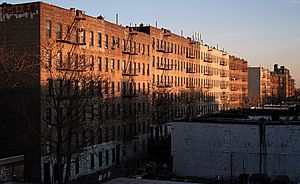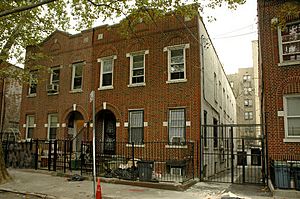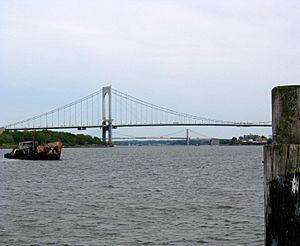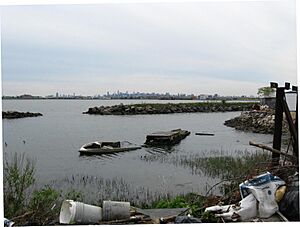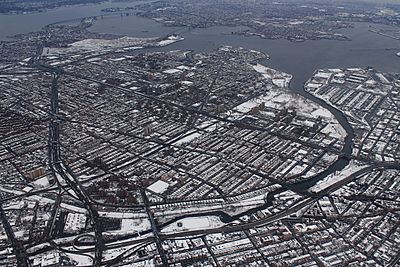Clason Point, Bronx facts for kids
Quick facts for kids
Clason Point
|
|
|---|---|
|
Neighborhood of the Bronx
|
|
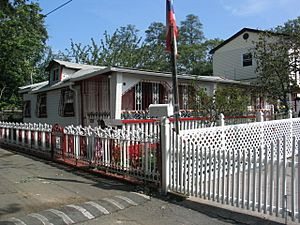
Houses in Harding Park at Clason Point's extreme southern tip
|
|
| Country | |
| State | |
| City | New York City |
| Borough | Bronx |
| Community District | Bronx 9 |
| Area | |
| • Total | 1.2 km2 (0.47 sq mi) |
| Population
(2010)
|
|
| • Total | 9,136 |
| • Density | 7,510/km2 (19,440/sq mi) |
| Economics | |
| • Median income | $65,176 |
| ZIP Codes |
10473
|
| Area code | 718, 347, 929, and 917 |
Clason Point is a neighborhood in the East Bronx, New York City. It is located on a piece of land that sticks out into the water, called a peninsula. This area includes smaller neighborhoods like Harding Park and Soundview.
Clason Point is bordered by Lafayette Avenue to the north. To the east, you'll find White Plains Road and Pugsley Creek Park. The East River is to the south, and the Bronx River is to the west.
Soundview Avenue is the main street that runs through Clason Point. This road used to be called Clason's Point Road. The Bruckner Expressway now cuts through the middle of the area.
Clason Point is part of Bronx Community Board 9. Its main ZIP Code is 10473. The NYPD's 43rd Precinct keeps the area safe.
Contents
History of Clason Point
Clason Point has a long and interesting history. It has been known by different names over the years.
Early Times and Native Americans
Long ago, the area near the Bronx River was called "Aquahung" by the Siwanoy people. They spoke an Algonquian language. Clason Point itself was known as "Snakapins," which meant "Land By The Two Waters." It was home to a large Native American settlement with many homes.
European Settlers and Early Conflicts
Europeans started settling here in the early 1600s. The Cornell family built the first permanent European home around 1643. Because of them, the area became known as Cornell's Neck.
There were some conflicts between the Cornell family and the Siwanoy people. These events were sometimes called the "Pig Wars." The Cornell family had to escape by boat once, but they returned later. In 1654, a British settler named Thomas Pell made a peace agreement with some Siwanoy leaders.
From Farms to Fun Resorts
Later, the area was renamed Clason Point after Isaac Clason, a Scottish merchant who owned a lot of land. In the 1800s, people started coming to Clason Point for fun and entertainment. From 1883 to 1927, it was home to the Clason Point Military Academy.
In the early 1900s, Clason Point became a popular seaside resort. People would take ferries from College Point, Queens to enjoy the views and attractions. There were dancehalls and amusement parks. One famous saloon, Kane's, featured a singer named Helen Kane. She was known for her "Boop-oop-a-doop" phrase, which inspired the cartoon character Betty Boop.
Clason Point had trolley cars on its main street, Soundview Avenue. It was a mix of large houses, farms, and open fields. People could take ferryboats to downtown Manhattan. The amusement park here was so popular it was called "The Coney Island of the Bronx." It had dance halls, roller coasters, and a large saltwater swimming pool. Sadly, a strong windstorm in 1922 blew over the Ferris wheel, causing some deaths.
Becoming a Residential Area
The resort area started to decline in the 1930s due to the Great Depression. More people began living in Clason Point year-round. After World War II, there were plans to build public housing, but local residents stopped some of these ideas.
The former amusement park became the Shorehaven Beach Club in 1949. Later, in 1999, it was turned into the Shorehaven Condominiums. This is a gated community with many townhomes. More homes were built in the area in the 2000s.
Soundview Park, a large park in the South Bronx, was updated with new walking paths and play areas. Future plans aim to make it an even better place with trails, fishing spots, and boat launches. The neighborhood has become more diverse with people from different Latin American countries moving in. Crime rates have also gone down.
Today, the Harding Park part of Clason Point is sometimes called Little Puerto Rico. It has narrow streets and bungalow homes near the water. Some streets can flood when it rains a lot. The main shopping area is a bit far away.
People and Community
Clason Point is a diverse neighborhood. In 2010, the population of Soundview/Clason Point/Castle Hill was about 53,686 people.
The community is made up of many different groups. About 37% of residents are African American, and 57.8% are Hispanic or Latino. There are also White, Asian, and Native American residents.
Most people living in Clason Point are young and middle-aged adults. About 25% are under 18, and 29% are between 25 and 44 years old. The average life expectancy in this area is about 79.7 years.
Buildings and Land Use
Clason Point has many different types of homes. You'll find large apartment complexes, including public housing buildings. There are also older apartment buildings and multi-unit row-houses. Since the 1990s, many new row-houses and apartment buildings have been built. This means more people now own their homes.
The northern and eastern parts of the neighborhood have many shops and businesses. Westchester Avenue is a busy commercial area. Bruckner Plaza has large stores. Other main streets have places like supermarkets, pharmacies, and restaurants.
Public Housing Developments
Clason Point has several public housing developments managed by the New York City Housing Authority (NYCHA). These include:
- 1780 Watson Avenue (one 6-story building)
- 1471 Watson Avenue (one 6-story building)
- Boynton Avenue Rehab (three buildings)
- Sotomayor Houses (twenty-eight 7-story buildings)
- Bronx River Houses (nine 14-story buildings)
- Bronx River Addition (two buildings)
- Clason Point Gardens (forty-five 2-story buildings). This was the first NYCHA development in the Bronx.
- Monroe Houses (twelve buildings)
- Sack Wern Houses (seven 6-story buildings)
- Soundview Houses (thirteen 7-story buildings)
Parks and Fun Places
Clason Point has several parks where you can relax and play.
- Soundview Park is a large park covering about 205 acres. It has ballfields, playgrounds, and a path for walking and biking along the Bronx River. The park was built on land that was filled in starting in 1939.
- Pugsley Creek Park is on the eastern side of Clason Point. It surrounds a historic creek.
- Clason Point Park is on the southern tip of the peninsula. This used to be the site of the old amusement park. Now, it's a place where ferries land and people can go kayaking.
Neighborhood Sections
Clason Point includes a few smaller sections:
- Bronx River: This area is bordered by the Cross-Bronx Expressway to the north, White Plains Road to the east, Westchester Avenue to the south, and the Bronx River to the west. It includes the Bronx River Houses.
- Harding Park: This section is bordered by Lacombe Avenue to the north, Pugsley's Creek to the east, the East River to the south, and the Bronx River to the west. Harding Park has many bungalow homes. It feels a bit separate from the rest of the Bronx.
- Soundview-Bruckner: This area is bordered by Westchester Avenue to the north, White Plains Road to the east, the Bruckner Expressway to the south, and the Bronx River to the west. It includes the Bronxdale Houses.
- Soundview: This section is bordered by the Bruckner Expressway to the north, White Plains Road to the east, Lacombe Avenue to the south, and the Bronx River to the west. Soundview includes Soundview Park and several public housing developments.
Fire Safety
The New York City Fire Department (FDNY) has a fire station in Clason Point. It's Engine Co. 96/Ladder Co. 54, located at 1689 Story Avenue.
Mail and ZIP Codes
Clason Point uses two ZIP Codes. The area north of the Bruckner Expressway is in 10472. The area south of the Bruckner Expressway is in 10473. The United States Postal Service has three post offices nearby:
- Clason Point Station – 829 Soundview Avenue
- Cornell Station – 1950 Lafayette Avenue
- Soundview Station – 1687 Gleason Avenue
Education and Schools
Clason Point has a similar number of college-educated residents compared to the rest of New York City. About 23% of adults aged 25 and older have a college degree or higher.
Students in Clason Point have shown improvement in math and reading. The percentage of students doing well in math went from 23% in 2000 to 44% in 2011. Reading achievement also increased.
However, more elementary school students in Clason Point miss school often compared to the rest of the city. About 28% of elementary students miss 20 or more days of school each year. Also, 69% of high school students graduate on time, which is a bit lower than the city average.
Schools in Clason Point
Here are some public schools located in Clason Point:
- The Bronx Mathematics Preparatory School (for grades 6–8)
- Archimedes Academy for Math Science and Technology Applications (for grades 6–12)
- Women's Academy of Excellence (for grades 6–12)
Libraries
The New York Public Library (NYPL) has three branches close to Clason Point:
- The Clason's Point branch is at 1215 Morrison Avenue. It opened in 1952.
- The Castle Hill branch is at 947 Castle Hill Avenue. It opened in 1963.
- The Soundview branch is at 660 Soundview Avenue. It opened in 1973.
Getting Around (Transportation)
You can get around Clason Point using public transportation.
Subway
The local New York City Subway line is the IRT Pelham Line (6 <6> trains). It runs along Westchester Avenue.
Buses
The following MTA Regional Bus Operations bus routes serve Clason Point:
- Bx27: This bus goes to Simpson Street.
- Bx39: This bus goes to Wakefield–241st Street.
Ferry Service
In 2015, the mayor announced that ferry service would start in the neighborhood. NYC Ferry's Soundview route began serving Clason Point on August 15, 2018. This makes it easier to travel by water.


